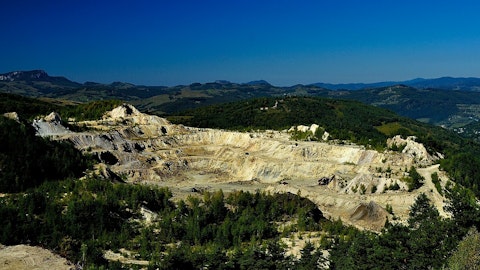Kerry Smith: Okay. And I guess we see those results sometime mid-year next year, I guess?
George Burns: Correct.
Kerry Smith: Okay, great. And the last question I had was just for Paul on the depreciation in the quarter was low route, certainly relative to your guidance, which I think was 280 million to 290 million for the year. And your depreciation in Q1 was like 54.5 million. Just wondering if there was something weird that went on in the quarter and that’s why the number was low or what we should be thinking about for depreciation per ounce for the rest of the year?
Paul Ferneyhough: Kerry, as I reflect on depreciation in the first quarter, vis-a-vis our full year guidance, there’s a couple of things that jump out at me. First of all, we did have a one-off adjustment at Efemcukuru for about 4 million to 5 million, and I don’t expect to see another one-off adjustment like that. Secondly, we are clearly backend weighted in line with our production volume, so we will see a move towards a higher quarterly charge as the unit volumes move up. And then finally, Kisladag, as we are seeing that stacking on the north leach pad, it’s caused us to go back and say, look, there’s a longer light there and therefore the unit rate is a little bit lower. So all-in-all, I’m expecting full-year to be very much at the bottom end of the range. And so as far as the quarterly charge is concerned, you just need to think about something that’s going to add up to around 280.
Kerry Smith: Okay. That’s helpful. Okay. That’s fabulous. Thanks very much guys.
George Burns: Thanks, Kerry.
Operator: [Operator Instructions] Our next question comes from Delvin Xie of Scotiabank. Please go ahead.
Delvin Xie: Thank you, guys. Congratulations for the quarter. And a couple questions from me. In terms of inflationary pressure, do you feel, put this inflation in certain areas? Do you see easing of the inflation pressure? And then you mentioned labor for Lamaque, the fuel for Kisladag? Thank you.
George Burns: Well, I mean, I guess first I’d start with Skouries. I think the updated capital estimate embedded the inflationary impacts we expect, as we deliver this over the next year and a half. Beyond our focus on this quarter’s impact, I wouldn’t say we we’re worried about any other inflationary pressures across the business. Diesel in Turkey, obviously our open pit at Kisladag is fairly reliant on truck haulage. And so diesel costs do impact us. And we’ve seen an upward trend in diesel costs hitting the industry. But the rest of our operations are underground, less reliant. And as Simon pointed out, we’re beginning to pivot towards battery electric trucks, which will benefit us not only in the diesel cost reduction. But also the less particulates in the underground and positively impacting ventilation volumes.
Delvin Xie: Okay. [Indiscernible] like Forex, the main driver or…
George Burns: Sorry. I couldn’t hear that very well. You were asking a question about Kisladag?
Delvin Xie: About Turkiye, the Q1 cost been better. So is it the Forex being the main driver or any you could spend out?
George Burns: Yes. So we’ve certainly seen a further weakening in the Turkish lira versus the U.S. dollar. And so that means that where we may have seen increases in labor costs, for example, that is broadly offset. We expect labor costs to be up slightly. But we still believe the Turkish lira will continue to devalue where modeling an average for the year of 33 to one for the U.S. dollar with it being high 30 at the beginning of the year and then devaluing to 35 at the end of the year. So that will obviously help offset any inflation in terms of its reporting in U.S. dollars.
Delvin Xie: Appreciate the color. Thank you. And also in terms of production profile for the remainder of the year, so there’s a 45, 55, first half to second half still hold to and increase in Kisladag for Q2, Efemcukuru, Olympias to be second half weighted to say, the Lamaque to be even for the rest the year?
George Burns: Yes. So the 45, 55 still holds true first half to second half. And as we spoke earlier, we expect Q2 to be a bit stronger than Q1, largely driven by Kisladag throughput and kinetics and then partially impacted by underground ore grade. It’s just changes in the stopes that will be mining. But I think the key 45, 55 still holds true for the year.
Delvin Xie: Okay. I think you are saying Kisladag, Efemcukuru and Olympias to be second half weighted or about.
George Burns: That’s correct.
Delvin Xie: Okay. That’s it. Really appreciate. Thank you so much.
George Burns: Thank you.
Operator: That is all the time we have for today and this includes the question-and-answer session as well as today’s conference call. You may disconnect your lines. Thank you for participating and have a pleasant day.
Follow Eldorado Gold Corp New (NYSE:EGO)
Follow Eldorado Gold Corp New (NYSE:EGO)
Receive real-time insider trading and news alerts



